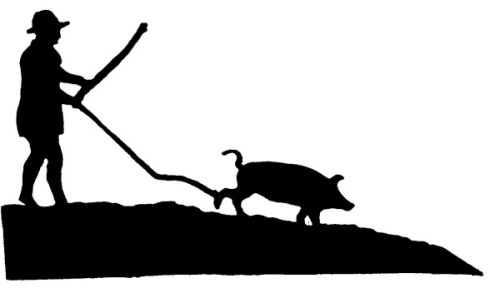|
Persuasions #4, 1982 Pages 14-15 PORCINE TITTLE-TATTLE D. Dean Cantrell Berry College, Mount Berry, Georgia 30149 Among the foods served at Hartfield – minced chicken, scalloped oysters, fish, delicate fricassee of sweetbread, and roast mutton and rice pudding (for which the little Knightleys rush home) – the most interesting to an American is its pork.1 In considering “small, trifling presents, of anything uncommon” for the Bateses, Mr. Woodhouse tells George Knightley “ … we have killed a porker” (p. 172), a line evoking an oft-discussed one Jane writes Cassandra, delightful to most other devotees, chagrining to a few: “We are to kill a pig soon” (p. 28). She has Mr. Woodhouse declare: “Hartfield pork is not like any other pork” (p. 172). What makes it so, undoubtedly, is its cut, method of cooking, and, just possibly, its curing. Leaving to Emma the responsibility for sending the meat, Mr. Woodhouse, unsure whether “a loin or a leg” is given, recommends “we had better send the leg” (p. 172). The cut piques interest for the text makes clear it is distinguished from not only “loin” but “hind-quarter.” As elsewhere, Jane must be accurate in detail. Living as she did near Cheesedown Farm, she had experiences upon which to draw: “My father,” she writes Cassandra, “furnishes him (their brother) with a pig from Cheesedown; it is already killed and cut up”; and her mother “means to pay herself for the salt and the trouble of ordering it to be cured by the sparibs, the souse and the lard” (pp. 57-58). Other examples are in her letters where she also carefully differentiates in terminology: “the sumptuous provision of a neck of Mutton” (p. 289), “a brace of Pheasants” (p. 435), “Joints of Mutton” (p. 466), etc. Her accuracy, furthermore, is reinforced by a somewhat surprised Harrods butcher who assured me of the contemporary Englishman’s fondness of a leg of pork, as we stood talking porcine matters across a counter wherein lay as proof a half leg. But to an American a green or fresh ham is a more familiar term. The method of cooking is of interest. Whereas Mr. Woodhouse prefers his pork fried and trusts the Bateses will fry theirs “as our’s are fried, without the smallest grease,” he knows the leg may not be so cooked, announcing that if the Bateses do not oversalt it, it can be wholesome if “thoroughly boiled, just as Serle boils our’s” (p. 172). In proffering gratitude, Miss Bates, ignorant of Mr. Woodhouse’s cooking preferences, exclaims: “My dear sir, if there is one thing my mother loves better than another, it is pork – a roast loin of pork” (p. 175). And two pages over she quite spontaneously announces she is determined not to call upon schoolmistress Mrs. Goddard for “I really do not think she cares for anything but boiled pork,” adding “when we dress the leg, it will be another thing.” What method of cooking is hers? The Harrods butcher’s astonishment over my question as to whether a leg is ever fried rules out that method for even “with the smallest grease” its lean meat would be quite tasteless even for Mr. Woodhouse; the arrant comment on Mrs. Goddard eliminates boiling; and that leaves Miss Bates’s Patty roasting the small and delicate porker, thereby unwittingly thwarting her benefactor who could not bear it so cooked, holding that “no stomach can bear roast pork” (p. 172). Miss Bates thereby ironically avenges herself and her mother in being denied the delicate fricassee of sweetbread and in promising to ingest Mrs. Wallis’s apples, thrice baked. Americans would follow Miss Bates’s preference, choosing to boil only if the pork were over-salted. The superiority of Hartfield pork lay, perhaps, in its manner of curing, though that process goes unmentioned. With that, too, Jane must have been familiar, living, not in Surrey, the site of Hartfield, but in Hampshire, famous for its pork. According to William Cobbett, to whom a “hog is a capital thing,” two ways of curing existed in the eighteenth century: taking the hair off by scalding or by burning. Scalding, he thought, slackened the skin, making it loose and flabby, whereas burning tightened, contracting sinew and vein, the taste being very different from that of a scalded hog. To this latter method Hampshire, and, no doubt, Hartfield, owed its reputation of excellence. The porcine scene illustrates not only Jane’s “little bit (two Inches wide) of Ivory” reflecting the essential egocentricity of valetudinarian Mr. Woodhouse and myopic Miss Hetty, but most of all Emma’s generosity (a trait with which earlier in our acquaintance she has not fully impressed us), for she sends not a leg nor a loin but a “hind-quarter,” even if that cut is also technically unknown in America, being labelled rather a “side of Pork.” The scene also points up how Jane speaks to the contemporary age. Because of the confusion resulting internationally over differing names for the same cuts of meat, ICMSIC (Industrial Co-operative Meat Identification Standards Committee) has since 1972 entered upon a campaign to insure a uniform retail meat identity standard. Reading Jane Austen can illuminate not only a contemporary action but also help us understand our own provincialism.
1
All
references are to R. W. Chapman’s Emma,
The Novels of Jane Austen,
3rd ed. IV (London: Oxford University Press, 1974) and Jane
Austen’s Letters to Her Sister Cassandra and Others,
2nd ed. (Oxford: Oxford University Press, 1979).
|

